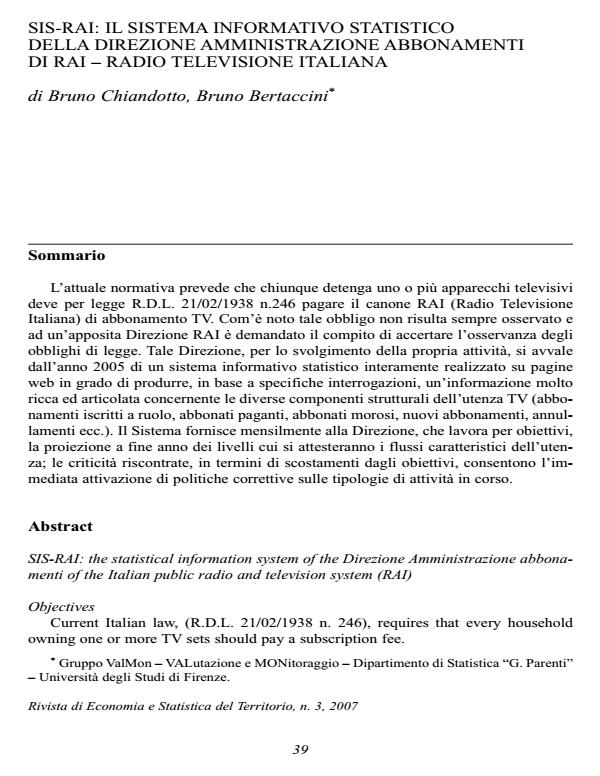SIS-RAI: il Sistema Informativo Statistico della Direzione Amministrazione Abbonamenti di RAI Televisione Italiana
Titolo Rivista RIVISTA DI ECONOMIA E STATISTICA DEL TERRITORIO
Autori/Curatori Bruno Chiandotto, Bruno Bertaccini
Anno di pubblicazione 2008 Fascicolo 2007/3
Lingua Italiano Numero pagine 14 P. 39-52 Dimensione file 241 KB
DOI
Il DOI è il codice a barre della proprietà intellettuale: per saperne di più
clicca qui
Qui sotto puoi vedere in anteprima la prima pagina di questo articolo.
Se questo articolo ti interessa, lo puoi acquistare (e scaricare in formato pdf) seguendo le facili indicazioni per acquistare il download credit. Acquista Download Credits per scaricare questo Articolo in formato PDF

FrancoAngeli è membro della Publishers International Linking Association, Inc (PILA)associazione indipendente e non profit per facilitare (attraverso i servizi tecnologici implementati da CrossRef.org) l’accesso degli studiosi ai contenuti digitali nelle pubblicazioni professionali e scientifiche
SIS-RAI: the statistical information system of the Direzione Amministrazione abbonamenti of the Italian public radio and television system (RAI) (by Bruno Chiandotto, Bruno Bertaccini) . Objectives Current Italian law, (R.D.L. 21/02/1938 n. 246), requires that every household owning one or more TV sets should pay a subscription fee. Because this norm is not always complied with, a specific agency (Direzione Amministrazione Abbonamenti) was created in order to enforce it, thereby acquiring new subscriptions, maintaining the old subscription portfolio and recuperating subscriptions not paid previously. The objective of the present paper is to illustrate the main characteristics of the Statistical Information System implemented by the authors for RAI. Methods and Results The Statistical Information System has to deliver information regarding the different structural components of the TV audience. In addition, the information system should provide the agency with year-end forecasts regarding flows in the characteristics of the TV audience. These forecasts are made utilizing the methodology proposed by Balestra and Matoussi in 1984. This model, suitably generalized and adapted to the case on hand, should generate three different forecasts, (Low, Average, High) which are updated each month on the basis of the newly-acquired data. Since 2005, the Agency has made large use of the Statistical Information System software for its activities, that is implemented on intranet website. The System now produces a rich and well organized set of information on the basis of specific queries (registered viewers, paying viewers, default debtors, new subscribers, cancellations, ecc.) and the mentioned forecasts. These forecasts are then compared to the Agency’s pre-defined goals. If there are differences between the forecasts and the goals, and especially if these fall short of the goals, attention must be given to the most critical aspects which have emerged, in order to implement corrective interventions. Conclusions The peculiarity of the implemented system is the transformation of statistical data in information that becomes knowledge directly utilizable for decision purposes.
Bruno Chiandotto, Bruno Bertaccini, SIS-RAI: il Sistema Informativo Statistico della Direzione Amministrazione Abbonamenti di RAI Televisione Italiana in "RIVISTA DI ECONOMIA E STATISTICA DEL TERRITORIO" 3/2007, pp 39-52, DOI: